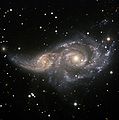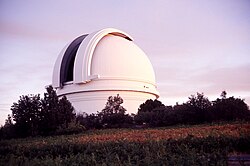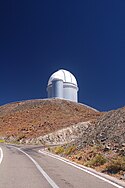ESO-3,6-m-Teleskop
Das ESO-3,6-m-Teleskop ist ein optisches und Nahinfrarot-Spiegelteleskop mit 3,57-m-Spiegel in äquatorialer Gabelmontierung. Es gehört zur Europäischen Südsternwarte ESO und ist Teil des La-Silla-Observatoriums in Chile.
Das Teleskop befindet sich in einer Höhe von 2400 m bei den Koordinaten 29° 15′ 39,5″ S, 70° 43′ 54,1″ W.
Erbaut im Jahr 1976, war es ab 1977 voll betriebsbereit. Ende der 70er Jahre des 20. Jahrhunderts war es mit seinen knapp 3,6 m Spiegeldurchmesser und einer Spiegelfläche von 8,6 m2 eines der größten optischen Teleskope der Welt und unterstützte damit etliche Errungenschaften der Naturwissenschaften und Technik. Der Hauptspiegel wurde durch das Verschweißen von sechseckigen, 50 cm dicken Quarzglasblöcken von der Firma Corning hergestellt.[1]
Das Teleskop wartete in den 1980er Jahren mit einer der ersten adaptiven Optiken für die astronomische Gemeinde auf. Eine Renovierung im Jahr 1999 und die Ausstattung mit einem neuen Sekundärspiegel im Jahr 2004 brachten es auf den jetzigen Stand. Ab dem Jahr 2009 war das Teleskop dann wesentlich an der Entdeckung von 75 möglichen Exoplaneten beteiligt.[2]
Instrumente
Seit April 2008 ist das HARPS, ein Akronym für High Accuracy Radial velocity Planet Searcher, das einzige Instrument am ESO-3,6-m-Teleskop. HARPS ist ein glasfasergeführter, hoch auflösender Echelle-Spektrograf, gewidmet allein der Suche nach extrasolaren Planeten.
Ehemalige Instrumente
- CES: ein Spektrograf mit einem spektralen Auflösungsvermögen von bis zu 235.000 im Wellenlängenbereich von 346 – 1028 nm
- EFOSC2: Der ESO Faint Object Spectrograph and Camera (v.2), ein sehr vielseitig einsetzbares Instrument für niedrige Auflösung und Bilderstellung, inzwischen auch am New Technology Telescope verbaut.
- TIMMI-2: Das Thermal Infrared MultiMode Instrument arbeitete im Spektralbereich von 3 μm bis 25 μm.
- ADONIS: Ein Akronym für ADaptive Optics Near Infrared System, war ein adaptives Optiksystem der zweiten Generation.[3] Mehr als 40 naturwissenschaftliche Peer-Review Artikel wurden auf Datenbasis dieses Instruments veröffentlicht.[4] ADONIS ist die ausgereifteste Version diverser Adaptive Optik (AO) Prototypen. In seiner finalen Version vom Oktober 1996 wurde es offizielles ESO Instrument,[5] und 2001 außer Dienst gestellt. ADONIS war das erste AO-System, mit dem eine größere Anzahl an Astronomen arbeitete.
Entdeckungen
Das ESO-3,6-m-Teleskop war seit seinem ersten Licht an etlichen naturwissenschaftlichen Entdeckungen maßgeblich beteiligt. Speziell in letzter Zeit wurde es durch das HARPS einerseits möglich, im Jahr 2009 den seinerzeit masseärmsten Exoplaneten aufzufinden; Gliese 581 e hat lediglich die doppelte Masse unserer Erde.[6] Andererseits wurde das Planetensystem mit den bis derzeit meisten Planeten entdeckt; sieben Planeten umkreisen den sonnenähnlichen Stern HD 10180.[7]
Das Teleskop war ebenso Teil in der Aufklärung des jahrzehntealten Rätsels der Masse der variablen Sternenklasse der Cepheiden. Durch HARPS wurde es ermöglicht, innerhalb eines Bedeckungsdoppelsternsystems mit einem Cepheiden und einem normalen Stern die genaue Masse des Cepheiden zu ermitteln, mit dem Ergebnis einer Bestätigung der Theorie des Zusammenhangs von Sternenmasse und Pulsationsdauer.[8]
Die Entdeckung des Exoplaneten Gliese 581 c durch Stéphane Udry u. a. der Sternwarte der Universität Genf wurde am 24. April 2007 verkündet.[9] Das Team benutzte das HARPS und analysierte die Radialgeschwindigkeiten, um die Wirkung des Planeten auf den Stern zu messen.[10]
Vergleich mit anderen Teleskopen der gleichen Generation
| # | Name / Observatorium | Abbildung | Apertur (cm) | M1 Spiegelfläche (m2) | Meeres- Höhe (m) | Erstes Licht | Hauptfürsprecher |
|---|---|---|---|---|---|---|---|
| 1 | BTA-6 Special Astrophysical Obs | 605 | 26 | 2070 | 1975 | Mstislav Keldysh | |
| 2 | Hale-Teleskop Palomar-Observatorium | 508 | 20 | 1713 | 1949 | George Ellery Hale | |
| 3 | Mayall Telescope Kitt Peak National Obs. | 401 | 10 | 2120 | 1973 | Nicholas Mayall | |
| 4 | CTIO 4m/Blanco Telescope CTIO Obs. | 401 | 10 | 2200 | 1976 | Nicholas Mayall | |
| 5 | Anglo-Australian Telescope Siding Spring Obs. | 389 | 1742 | 1974 | Prince Charles | ||
| 6 | ESO 3.6 Telescope ESO La Silla Obs. | 357 | 8,8 | 2400 | 1976[11] | Adriaan Blaauw | |
| 7 | Shane Telescope Lick Observatory | 305 | 1283 | 1959 | Nicholas Mayall |
Teleskop und Lokation
Rechts im Vordergrund das Leonhard-Euler-Teleskop, das ESO-3,6-m-Teleskop im Hintergrund
Baustelle des ESO-3,6-Meter-Teleskops.[12]
Bilder
Bilder zweier gravitativ interagierender Spiralgalaxien aufgenommen mit dem EFOSC2 am ESO-3,6-m-Teleskop. Credit: ESO
Weiteres
Einzelnachweise
- ↑ Adriaan Blaauw: ESO's early history, 1953 - 1975. VIII. The 3.6-m telescope project; from concept to the late 1960's. In: The Messenger. Band 61, 1990, S. 27–36, bibcode:1990Msngr..61...27B.
- ↑ 32 planets discovered outside solar system - CNN.com. In: CNN, 19. Oktober 2009. Abgerufen am 4. Mai 2010.
- ↑ Jack B. Zirker: An acre of glass: a history and forecast of the telescope. JHU Press, 2005, ISBN 0-8018-8234-6, S. 204.
- ↑ ADS query results for "ADONIS"
- ↑ Gérard Rousset, Jean-Luc Beuzit: Adaptive optics in astronomy. Hrsg.: François Roddier. Cambridge University Press, 1999, ISBN 0-521-55375-X, The COME-ON/ADONIS systems, S. 171 ff.
- ↑ Lightest exoplanet yet discovered, ESO. 21. April 2009. Abgerufen am 26. Mai 2011.
- ↑ Richest Planetary System Discovered, ESO. 24. August 2010. Abgerufen am 26. Mai 2011.
- ↑ Pulsating Star Mystery Solved, ESO. 24. November 2010. Abgerufen am 26. Mai 2011.
- ↑ Ker Than: Major Discovery: New Planet Could Harbor Water and Life, space.com. 24. April 2007. Abgerufen am 29. April 2007.
- ↑ Ker Than: Planet Hunters Edge Closer to Their Holy Grail, space.com. 24. Februar 2007. Abgerufen am 29. April 2007.
- ↑ Telescopes and Instrumentation, the ESO 3.6-metre Telescope. Abgerufen am 2. Mai 2011 (englisch).
- ↑ Three Very Different Telescopes at La Silla. In: ESO Picture of the Week. Abgerufen am 8. Mai 2012.
Weblinks
- ADONIS-ESO-Webseite (englisch)
- HARPS-ESO-Webseite (englisch)
- ESO Homepage (englisch)
- ESO-3,6-m-Teleskop-Homepage (englisch)
Auf dieser Seite verwendete Medien
Autor/Urheber: Cédric Foellmi, Lizenz: CC BY 2.5
Vue nocture du télescope de 3.6 mètres et du télescope suisse à l'Observatoire de La Silla, au Chili.
Главная обсерватория (Большой Телескоп Азимутальный) (trans. "Main observatory (large telescope azimuthal) [at the Special Astrophysical Observatory of the Russian Academy of Science]")
Autor/Urheber: ESO, Lizenz: CC BY 3.0
Panoramic view of the ESO 3.6-metre telescope's dome
Autor/Urheber: ESO, Lizenz: CC BY 3.0
The 3.6-metre telescope at ESO's La Silla observatory.
Autor/Urheber: David walker in der Wikipedia auf Englisch, Lizenz: GFDL
David walker, der Nutzungsrechtsinhaber dieses Werkes, veröffentlicht es hiermit unter der folgenden Lizenz:
Autor/Urheber: ESO, Lizenz: CC BY 3.0
ESO turns fifty this year, and to celebrate this important anniversary, we are showing you glimpses into its history. Once a month during 2012, a special Then and Now Picture of the Week shows how things have changed over the decades at the La Silla and Paranal observatory sites, the ESO offices in Santiago de Chile, and the Headquarters in Garching bei München, Germany.
These two photographs were taken on the highest peak of La Silla, a mountain with an altitude of 2400 metres, at the edge of the Chilean Atacama Desert. La Silla was ESO’s first observatory site. The historical photograph, taken in 1975, shows some of the trucks and other equipment used for the construction of the dome of the ESO 3.6-metre telescope, which was underway behind the photographer. On the left are the water tanks for the site.
In the modern-day photograph, three new telescopes have appeared, all looking very different from each other. To the right of the water tanks is the ESO New Technology Telescope (NTT), which had its first light on 23 March 1989. This 3.58-metre telescope was the first ever to have a computer-controlled main mirror, which could adjust its shape during observations to optimise image quality. The octagonal enclosure housing the NTT is another technological breakthrough, ventilated by a system of flaps that makes air flow smoothly across the mirror, reducing turbulence and leading to sharper images.
To the right of the NTT is the Swiss 1.2-metre Leonhard Euler Telescope, which has a more traditional dome-shaped enclosure. It is operated by the Geneva Observatory at the Université de Genève in Switzerland, and had its first light on 12 April 1998. It is used to search for exoplanets in the southern sky; with its first discovery being a planet in orbit around the star Gliese 86 (see eso9855). The telescope also observes variable stars, gamma-ray bursts and active galactic nuclei.
In the foreground on the right is a building nicknamed the sarcofago (sarcophagus). This houses the TAROT (Télescope à Action Rapide pour les Objets Transitoires, or Rapid Action Telescope for Transient Objects), which started work at La Silla on 15 September 2006. This fast moving, relatively tiny 25-centimetre robotic telescope reacts extremely quickly to alerts from satellites about gamma-ray bursts, to pinpoint the positions of these dramatic but fleeting events. Observing these cosmic explosions lets astronomers study the formation of black holes and the evolution of stars in the early Universe. TAROT is operated by a consortium led by Michel Boër from Observatoire de Haute Provence in France.
The NTT is operated by ESO, while the Leonhard Euler Telescope and TAROT are among the national and project telescopes hosted at La Silla. Even today, over 40 years after its inauguration, La Silla remains at the forefront of astronomy.(c) Coneslayer in der Wikipedia auf Englisch, CC BY 3.0
The en:art deco dome of the en:Hale Telescope at en:Palomar Observatory, opening at dusk
Autor/Urheber: ESO, Lizenz: CC BY 3.0
Early evening scenery at the ESO La Silla observatory. To the left is the decommisioned 15-metre dish of the Swedish-ESO Submillimetre Telescope (SEST), and on the right in the background is the dome of the ESO 3.6-metre telescope, at the highest point of the mountain. The southern Milky Way is seen along the right border of the SEST and above the 3.6 metre telescope. There is an upside-down reflection of the sky and the horizon behind the photographer in the highly polished antenna dish of the SEST.
Autor/Urheber: ESO, Lizenz: CC BY 4.0
In this image, two spiral galaxies, similar in looks to the Milky Way, are participating in a cosmic ballet, which, in a few billion years, will end up in a complete galactic merger — the two galaxies will become a single, bigger one. The fatal gravitational attraction of NGC 2207 is already wreaking havoc throughout its smaller partner, distorting IC 2163’s shape and flinging out stars and gas into long streamers that extend over 100 000 light-years. The space between the individual stars in a galaxy is so vast, however, that when these galaxies collide, virtually none of the stars in them will actually physically smash into each other.
Autor/Urheber: ESO, Lizenz: CC BY 4.0
NGC 520 — also known as Arp 157 — looks like a galaxy in the midst of exploding. In reality, it’s the exact opposite. Two enormous spiral galaxies are crashing into each other, melding and forming a new conglomerate. This happens slowly, over millions of years — the whole process started some 300 million years ago. The object, about 100 000 light-years across, is now in the middle stage of the merging process, as the two nuclei haven’t merged yet, but the two discs have. The merger features a tail of stars and a prominent dust lane. NGC 520 is one of the brightest interacting galaxies in the sky and lies in the direction of Pisces (the Fish), approximately 100 million light-years from Earth. This image was taken by the ESO Faint Object Spectrograph and Camera attached to the 3.6-metre telescope at La Silla in Chile. It is based on data obtained through B, V, R and H-alpha filters.
Autor/Urheber: Diceman Stephen West, Lizenz: CC BY-SA 3.0
Dome of the Anglo-Australian Telescope.
Autor/Urheber: ESO, Lizenz: CC BY 4.0
The 3.6-metre telescope at ESO's La Silla observatory from the road. La Silla, in the southern part of the Atacama desert of Chile was ESO's first observation site. The site is set 2400 metres above sea level, providing excellent observing conditions. ESO operates the 3.6-m telescope, the New Technology Telescope (NTT), and the 2.2-m Max-Planck-ESO telescope at La Silla. La Silla also hosts national telescopes, such as the 1.2-m Swiss Telescope and the 1.5-m Danish Telescope.
Autor/Urheber: Montebest, Lizenz: CC BY 3.0
Kitt Peak National Observatory telescopes; right: Mayall 4-m telescope; left: Bok 2.3-m (90 in) telescope




















